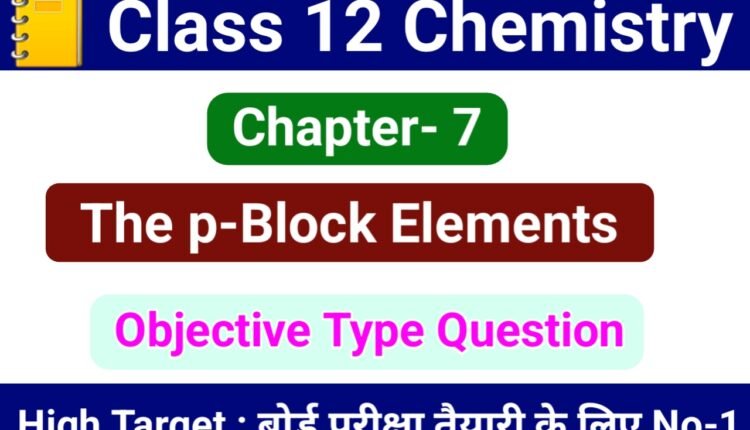7. THE P-BLOCK ELEMENTS
1. Boron shows diagonal relation with
(A) Al
(B) C
(C) Si
(D) Sn
Answer ⇒ (C)
2. Catenation property is maximum in
(A) phosphorus
(B) carbon
(C) sulphur
(D) zinc
Answer ⇒ (B)
3. Which one of the following is an electrophilic reagent ?
(A) BF3
(B) NH3
(C) H2O
(D) None of these
Answer ⇒ (A)
4. Element found from sea water is
(A) Magnesium
(B) Sodium
(C) Iodine
(D) None of these
Answer ⇒ (C)
5. The shape of XeF 4 is
(A) tetrahedral
(B) square planar
(C) pyramidal
(D) linear
Answer ⇒ (B)
6. Which one of the following is the strongest lewis acid ?
(A) BF3
(B) BC13
(C) BBr3
(D) BI3
Answer ⇒ (B)
7. Which one of the following does not form hydrogen bonding ?
(A) NH3
(B) H2O
(C) HCl
(D) HF
Answer ⇒ (C)
8. Main source of helium is
(A) Air
(B) Radium
(C) Monazite
(D) Water
Answer ⇒ (C)
9. Which one of the following element is liquid at normal temperature ?
(A) zinc
(B) mercury
(C) bromine
(D) water
Answer ⇒ (B)
10. Which one of the following is least basic ?
(A) NCl3
(B) NBr3
(C) NI3
(D) NF3
Answer ⇒ (C)
11. H2SO4 is a/an
(A) acid
(B) base
(C) alkali
(D) salt
Answer ⇒ (A)
12. Modern periodic table is given by
(A) Debonair
(B) Mendeleef
(C) Mendel
(D) None of these
Answer ⇒ (B)
13. Which one of the following elements is found in free state in nature ?
(A) Sodium
(B) Iron
(C) Zinc
(D) Gold
Answer ⇒ (D)
14. Which of the following is the strongest oxidising agent ?
(A) F2
(B) Cl2
(C) I2
(D) Br2
Answer ⇒ (A)
15. Which of the following has maximum ionisation potential ?
(A) Al
(B) P
(C) Si
(D) Mg
Answer ⇒ (B)
16. The number of P-O-P bonds in cyclic metaphosphoric acid is
(A) 2
(B) O
(C) 3
(D) 4
Answer ⇒ (A)
17. Which of the following oxides is anhydride of nitrous acid ?
(A) N2O3
(B) NO2
(C) NO
(D) N2O4
Answer ⇒ (A)
18. Which oxide of nitrogen is obtained on heating ammonium nitrate at 250°C ?
(A) Nitric oxide
(B) Nitrous oxide
(C) Nitrogen dioxide
(D) Dinitrogen tetraoxide
Answer ⇒ (B)
19. Atomicity of phosphorus is
(A) 1
(B) 2
(C) 3
(D) 4
Answer ⇒ (D)
20. The structure of white phosphorus is
(A) square-planar
(B) pyramidal
(C) tetrahedral
(D) trigonal planar
Answer ⇒ (C)
21. How many P-O-P bonds appear in cyclic meta phosphoric acid ?
(A) 4
(B) 3
(C) 2
(D) 1
Answer ⇒ (B)
22. Which of the following is a tetrabasic acid ?
(A) Hypophosphorus acid
(B) Metaphosphoric acid
(C) Pyrophosphoric acid
(D) Orthophosphoric acid
Answer ⇒ (C)
23. Which of the following is not correctly matched ?
(A) PCl5-sp3d hybridisation
(B) PCl3-sp3 hybridisation
(C) PCl5 (solid)-[PtCl4]+ [PtC6l-
(D) H3PO3-tribasic
Answer ⇒ (D)
24. Arrange the following hydrides of group 16 elements in order of increasing stability
(A) H2S < H2O < H2 Te > H2 Se
(B) H2O < H2Te < H2Se < H2S
(C) H2O < H2S < H2Se < H2Te
(D) H2Te < H2Se < H2S < H2O
Answer ⇒ (D)
25. Which of the following is not tetrahedral in shape ?
(A) NH4
(B) SiCl4
(C) SF4
(D) SO![]()
Answer ⇒ (C)
26. Which of the following are peroxiacids of sulphur ?
(A) H2SO5 and H2S2O8
(B) H2SO5 and H2S2O7
(C) H2S2O7 and H2S2O8
(D) H2S2O6 and H2S2O8
Answer ⇒ (A)
27. In solid state PCl5 is a
(A) covalent solid
(B) octahedral structure
(C) ionic solid with [PCl6l+ octahedral and [PCl4]– tetrahedral
(D) ionic solid with [PCl4]+ tetrahedral and [PCl6]– octahedral
Answer ⇒ (D)
28. Which of the following is an isoelectronic pair ?
(A) ICI2, CIO2
(B) Br2–, BrF2+
(C) CIO2, BrF
(D) CN–, O3
Answer ⇒ (B)
29. Which of the following is Tribasic ?
(A) H3PO2
(B) H3PO3
(C) H4P2O7
(D) H3PO4
Answer ⇒ (D)
30. In white phosphorus (P4) molecule, which one is not correct ?
(A) 6 P-P single bonds are present
(B) 4 P-P single bonds are present
(C) 4 lone pair of electrons are present
(D) ![]() bond angle is 60°
bond angle is 60°
Answer ⇒ (C)
31. Which is not a p-block elements ?
(A) Sn
(B) Al
(C) Mg
(D) Pb
Answer ⇒ (C)
32. H2SO2 is a/an
(A) acid
(B) base
(C) alkali
(D) all
Answer ⇒ (A)
33. What is the oxidation state of sulphur is SF6 ?
(A) +6
(B) -6
(C) +4
(D) -4
Answer ⇒ (A)
34. The geometry of PCl5 is
(A) Trigonal bipiramidal
(B) Octahedral
(C) Tetrahedral
(D) None
Answer ⇒ (A)
35. The shape of a XeF2 is
(A) Linear
(B) Triangular
(C) Angular
(D) Planar
Answer ⇒ (A)

